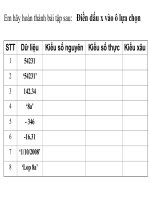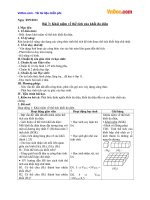slide môn học MySQL bài 3 implementing the SQL queries using MySQL i
Bạn đang xem bản rút gọn của tài liệu. Xem và tải ngay bản đầy đủ của tài liệu tại đây (1.01 MB, 48 trang )
Implementing the SQL queries
using MySQL-I
Session 6
Review
Databases are used to store information.
Relational Databases consists of several tables
Data types are classified as numeric, String,
Date and Complex
Normalization is the process in which the
redundancies in the database are removed
A Primary key is a field in the table which is
used as the unique identifier
An entity is said to be in the first normal form
if all the attributes are single valued
Indexing a database facilitates a faster find
and sort operations in the database
MySQL Database / Session 6 / Slide 2 of 48
Objectives
View and Alter the database
Select and Display the data from a table
Change the table definition
Delete a table along with its table
definition
MySQL Database / Session 6 / Slide 3 of 48
View Database
SHOW command is
used for viewing
list of
databases
present in the
server
SHOW DATABASES;
MySQL Database / Session 6 / Slide 4 of 48
View Database with LIKE
clause-I
To view the list of databases that begin
or contain the specified character in the
database name, the syntax is:
SHOW DATABASES [LIKE clause];
MySQL Database / Session 6 / Slide 5 of 48
View Database with LIKE
clause-II
Show all
databases that
begin with the
letter ‘E’
SHOW DATABASES
LIKE ‘E%’;
MySQL Database / Session 6 / Slide 6 of 48
View Tables- I
To view a list of tables of a database,
the syntax is:
SHOW TABLES [FROM database_name] [LIKE
clause];
MySQL Database / Session 6 / Slide 7 of 48
View Tables-II
Show the tables
of the Employee
database where
the database is
first activated
with USE command
SHOW TABLES;
MySQL Database / Session 6 / Slide 8 of 48
View Tables using FROM clause
Show the tables of the EMPLOYEE
database
SHOW TABLES FROM EMPLOYEE;
MySQL Database / Session 6 / Slide 9 of 48
View Tables using LIKE clause
Show tables that
begin with the
letter ‘E’ from
the EMPLOYEE
database
SHOW TABLES FROM
EMPLOYEE LIKE ‘E
%’;
MySQL Database / Session 6 / Slide 10 of 48
View Columns-I
To view the column structure of the
specified table from the specified
database, the syntax is:
SHOW COLUMNS FROM table_name [FROM
database_name] [LIKE clauses];
MySQL Database / Session 6 / Slide 11 of 48
View Columns-II
Show the column
structure of the
EMP_DETAILS table
SHOW COLUMNS FROM
EMP_DETAILS;
MySQL Database / Session 6 / Slide 12 of 48
View Columns using LIKE clause
Show columns that
starts with the
letter ‘H’ of the
SALARY_DETAILS
table from EMPLOYEE
database
SHOW COLUMNS FROM
SALARY_DETAILS LIKE
‘H%’;
MySQL Database / Session 6 / Slide 13 of 48
View Index keys-I
To view the index of a table from a
database, the syntax is:
SHOW INDEX FROM table_name [FROM
database_name];
MySQL Database / Session 6 / Slide 14 of 48
View Index Keys-II
Show the index
from the
EMP_DETAILS table
of the EMPLOYEE
database
SHOW INDEX FROM
EMP_DETAILS FROM
EMPLOYEE;
MySQL Database / Session 6 / Slide 15 of 48
View Default Variables
Show the values
of the system
variables
SHOW VARIABLES;
MySQL Database / Session 6 / Slide 16 of 48
View Default Variables using
LIKE clause-I
To view only those variables that match
the specified pattern, the syntax is:
SHOW VARIABLES [LIKE clause];
MySQL Database / Session 6 / Slide 17 of 48
View Default Variables using
LIKE clause-II
Show variables that
matches with the
pattern ‘HAVE’
SHOW VARIABLES LIKE
‘HAVE%’;
MySQL Database / Session 6 / Slide 18 of 48
View Server Status
Show the server
status
SHOW STATUS;
MySQL Database / Session 6 / Slide 19 of 48
View Table Status-I
To display more information about tables,
the syntax is:
SHOW TABLE STATUS [FROM database_name]
[LIKE clauses];
MySQL Database / Session 6 / Slide 20 of 48
View Table Status-II
Show the status of
all the tables of
the EMPLOYEE
database
SHOW TABLE STATUS
FROM EMPLOYEE;
MySQL Database / Session 6 / Slide 21 of 48
View rights of a user-I
To view a list of grants that can be
issued to duplicate grants for a user,
the syntax is:
SHOW GRANTS FOR user;
MySQL Database / Session 6 / Slide 22 of 48
View rights of a user-II
Show the list
of grants that
are issued to
root user
SHOW GRANTS FOR
root@localhost;
MySQL Database / Session 6 / Slide 23 of 48
Altering Database on the
file system-I
To modify the character set of a database,
the syntax is:
ALTER DATABASE database_name DEFAULT
CHARACTER SET charset_name;
MySQL Database / Session 6 / Slide 24 of 48
Altering Database on the
file system-II
To modify the character set to swe7 of a temporary
database named as TEST
ALTER DATABASE TEST DEFAULT CHARACTER SET swe7;
MySQL Database / Session 6 / Slide 25 of 48









